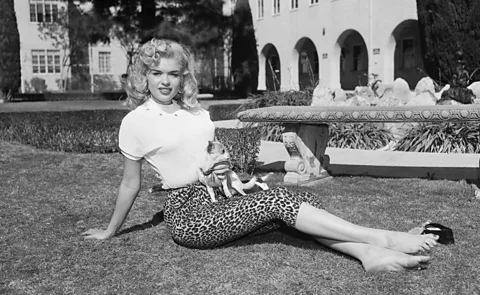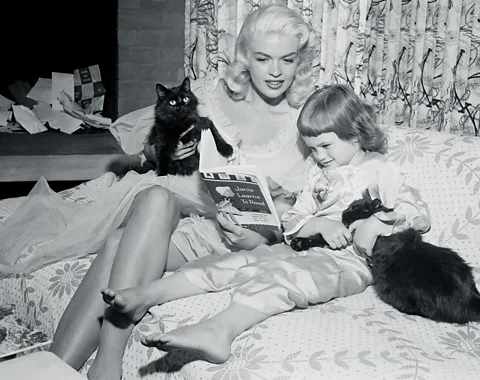 Alamy
AlamyOne of show business’s most glamorous – and notorious – images, there’s more to this 1957 snapshot of Sophia Loren and Jayne Mansfield than might first appear.
On the night of Sophia Loren’s “Welcome to Hollywood” dinner party in April 1957, Jayne Mansfield walked into the exclusive Romanoff’s restaurant in Beverly Hills with a plan. The swanky soirée being thrown by Paramount Studios was packed with some of the biggest Hollywood stars of the era, from Barbara Stanwyck and Montgomery Clift to Gary Cooper and Shelley Winters. But it would be a candid photograph of Mansfield and Loren that would earn the evening an indelible place in Hollywood history.
According to Eve Golden, the author of Jayne Mansfield: The Girl Couldn’t Help It, Mansfield wanted to make sure all eyes were on her. Signed to a seven-year contract by Warner Bros. in February 1955, the then 24-year-old blonde former Playboy Playmate was seen as a rival to Marilyn Monroe, who had been “causing problems” for 20th Century Fox, Golden tells the BBC. Released just eight months apart, the huge success of The Girl Can’t Help It (1956) and Will Success Spoil Rock Hunter? (1957) quickly established Mansfield as a star.
Sophia Loren was just 22 when she arrived in Hollywood. Born and raised in Italy under Mussolini’s fascist regime, Loren’s mother had her “own theatrical ambitions”, says Mary Ann McDonald Carolan, author of The Transatlantic Gaze: Italian Cinema, American Film. Loren entered beauty competitions as a teenager, where she met her future husband, the film producer Carlo Ponti, before she enrolled at the national film school of Italy. Ponti produced many of her early films. Post-World War Two Italy was swamped with Hollywood productions, too, as studios took advantage of the country’s lower production costs. “There was an extraordinary amount of artistic, economic, business, and cinematic exchange between Italy and America at that time,” Carolan tells the BBC.
After the success of 1953’s Aida and 1954’s The Gold of Naples, which screened at that year’s Cannes Film Festival, Paramount signed Loren, betting she could follow in the footsteps of her European counterparts Leslie Caron, Ingrid Bergman, and Marlene Dietrich.
 Alamy
AlamyBy April 1957, it was time for Loren to make her debut amongst the Hollywood elite at Romanoff’s, where Mansfield was the last guest to enter. She walked in covered by a “great big fur coat,” says Golden. When she took it off she was wearing a backless, extremely low-cut satin dress, which she knew would draw the attention of everyone in the room, particularly the photographers. “She sauntered over and plumped herself right down next to Sophia Loren,” says Golden. “It was definitely planned. Jane knew exactly what she was doing.” Photographers Delmar Watson and Joe Shere shot Loren and Mansfield next to each other. But while Mansfield stared directly down the lens, Loren was captured giving the most famous side-eye in Hollywood history, glaring at her tablemate’s cleavage.
Sixty-eight years later, it’s still one of the most iconic photographs in Hollywood history. Heidi Klum, Anna Nicole Smith, Sydney Sweeney and Maude Apatow, Sophia Vergara and Julie Bowen have all replicated it. The picture has endured because it presents Loren and Mansfield as polar opposites, the image symbolising elegance against bombast. Europe against America. Brunette against blonde. “It’s almost as if they got dressed purposely as a contrast,” says Carolan.
The photograph’s long legacy
There are troubling implications linked to the prolonged prevalence of the image, however. It highlights the media’s tendency to exaggerate female rivalry, pushing the harmful stereotype that women are always in competition. In reality, this was the only time they ever met, and Loren was perhaps worried that Mansfield was about to have a wardrobe failure in front of the press. In a 2014 interview with Entertainment Weekly, Loren recalled, “Look at the picture. Where are my eyes? I’m staring at her nipples because I am afraid they are about to come onto my plate. In my face you can see the fear. I’m so frightened that everything in her dress is going to blow – boom! – and spill all over the table.”
In her new documentary My Mom Jayne, Mansfield’s daughter Mariska Hargitay, who was three years old when she died, explores the actress’s career in a bid to discover the mother she barely knew. Speaking to Vanity Fair, Hargitay admits that she struggled with the photograph as a youth. “That was a rough one. To see another woman look at your mom like that was excruciating for me as a little girl.” Growing up, she developed a demure style that was the opposite of Mansfield’s glamorous public image. In the documentary, Hargitay admits that she decided to become a different kind of actor with a different image to her mother, whose career struggles she was keen to avoid. Now 61, the Law & Order: Special Victims Unit actor is reclaiming Mansfield’s story in the documentary – after all, this was a woman who could play violin and piano, spoke three languages, and who Life magazine called “Broadway’s smartest dumb blonde”.
 Getty Images
Getty ImagesThis moment was to be the only time where the two women’s careers criss-crossed, because while Loren’s star was on the rise, Mansfield’s was about to decline. In 1960, Loren won the best actress Oscar for Two Women, making her the first performer to win an Academy Award for a foreign-language role. Meanwhile, Mansfield’s stunt at Loren’s party was met harshly by 20th Century Fox. “This is when they realised they had signed a loose cannon,” says Golden. “I think this is the moment Fox really stopped taking an interest in furthering her career.”
In 1962, shortly after the death of Monroe, Mansfield was dropped by Fox, following three years of poor box-office performances. Suddenly, Golden says, with a “huge house to pay for and three children”, Mansfield started opening supermarkets and petrol stations to “support her family”. Golden believes that Mansfield’s career ambitions were scuppered because while “she knew where she wanted to go, she didn’t have the vaguest idea how to get there. She really needed a strong, smart manager.”
Meanwhile, Loren was able to turn to the Oscar-winning producer Ponti for advice. “She has this incredible knowledge from inside the film industry,” says Carolan. “She had a good sense of how to behave in the media circus. She couldn’t be manipulated by the press or by managers.” Loren was so astute at navigating her film career that she managed to combine Hollywood and Italian films while still remaining popular for nearly 70 years.
 Getty Images
Getty ImagesNot only did Mansfield’s fame fizzle out, but her life ended in tragedy. When she died in a car crash on 29 June, 1967, at the age of 34, she was driving from a night-time appearance at a Mississippi supper club to a midday radio interview in New Orleans. But the journey wasn’t unusual for someone who had insisted on appreciating every last drop of her fame since becoming a star. “She loved being in the spotlight. She loved her fans. She became her on-screen persona,” says Golden. “You could call her the first reality star because she lived her life in public. No matter what she was doing, she had photographers and reporters along with her.”
Carolan acknowledges that Mansfield helped to “pave the way for actresses like Sophia Loren, Brigitte Bardot, and Claudia Cardinale”, as she broke down barriers in the male-dominated industry by proudly owning her beauty and sexuality. And while their paths might have only crossed fleetingly, Loren told Entertainment Weekly that she is still repeatedly asked to sign the famous picture. She always refuses, though. “I don’t want to have anything to do with that. And also out of respect for Jayne Mansfield because she’s not with us anymore.”
My Mom Jayne is available to stream on Max.









Recent Comments